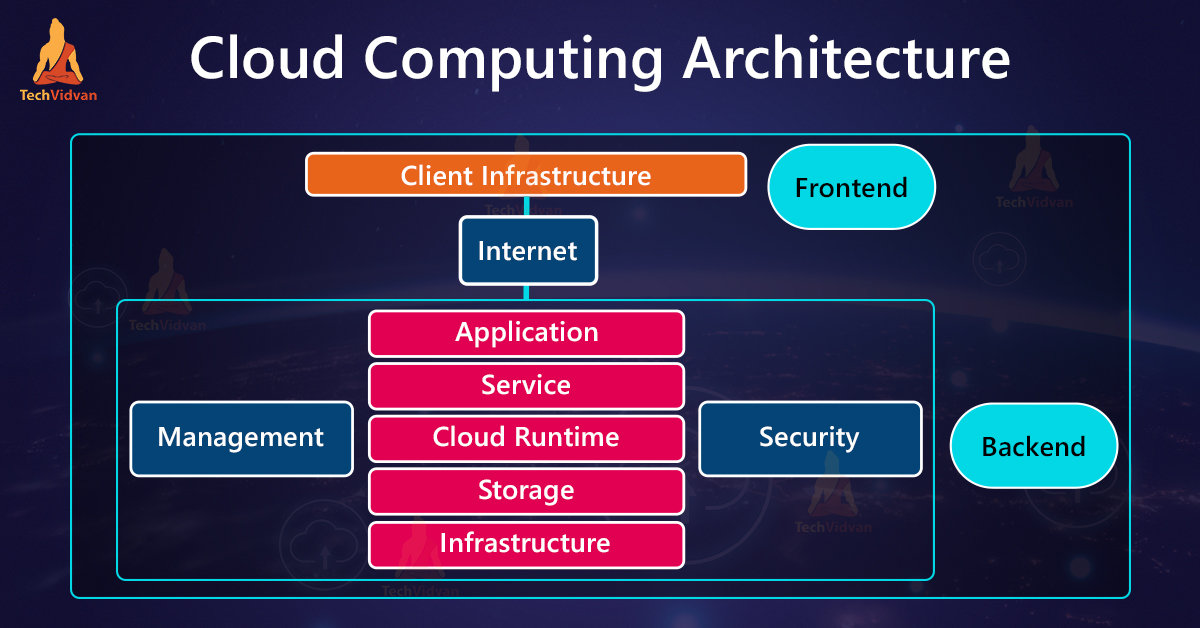Cloud Computing Architecture
Hello, bibliophiles. Welcome to the architecture of cloud computing. As we know, in today’s modern and developing world the organizations are adopting cloud technology. The key reason to adopt cloud technology is to store the information and access it from any part of the world with the help of the internet. Let’s start with cloud computing architecture.
Cloud Computing Architecture
Cloud Computing Architecture is a mixture of Service Oriented Architecture (SOA) and Event-Driven Architecture (EDA). The modules of Cloud Computing Architecture are mentioned below and they are as follows:
1. Client Infrastructure
2. Application Service
3. Runtime
4. Storage
5. Infrastructure
6. Management
7. Security
The Cloud Computing Architecture is categorized into two main aspects such as:
- Front End
- Back End
Front End
Front End is mainly used by the client-side. It contains the interfaces which are essential for accessing the platforms of cloud computing. The front End involves the web browser, which is used by web servers, for example, Google Chrome, Mozilla Firefox, Internet Explorer and others. It also has thin and fat clients, followed by tablets and mobile devices. Cloud Infrastructure is build with hardware and software components, For example, Data Storage, Server, Virtualization Software, etc.
Back End
Back End has the complete responsibility of monitoring all the programs responsible for running the applications on the Front End. It is mainly used by the service provider. It has to manage all the resources which are necessary for providing Cloud Computing Services. Back End involves massive amounts of data storage, security operations, virtual machines, servers, and many more.
- Application
Application in the Back End of Cloud Architecture refers to a platform or the software on which the client has access. In simple words, it will provide the service in the backend according to the client’s requirements.
- Service
Back End refers to three types of cloud services such as Infrastructure-as-a-Service (IaaS), Platform-as-a-Service (PaaS), and Software-as-a-Service (SaaS). Service also has the role of managing the class of service the user accesses.
- Cloud Runtime
In Back End Cloud, Runtime is referred to the provision of runtime and execution environment in the Virtual Machine.
- Storage
Cloud Computing Storage will offer flexible and scalable services along with the management of old stored data.
- Infrastructure
Cloud Infrastructure refers to hardware and the software unit, including servers, storage, network devices, virtualization software, etc.
- Management
Management of Back End components refers to managing units as application, service, runtime cloud, storage, infrastructure, other security mechanisms, etc.
- Security
Executing various security mechanisms in the Back End to secure the cloud assets.
- Internet
Internet Connection is the primary approach between the Front End and Back End. It creates the relation and communication between FrontEnd and BackEnd.
Best Practices of Cloud Architecture
- Reduces the Cost
The user can benefit from automation, managed service providers, and utilization tracking to remove unnecessary bills or expenses in cloud computing.
- Secure Disaster Recovery
Automating recovery for avoiding expensive downtime and making sure a speedy recovery from disturbance in service. Monitoring and using an unessential network can guarantee a high architecture.
- Implant Security
Protecting all cloud infrastructure layers with techniques such as data encryption, management of patches, and strict policies will cover the Cloud from hackers.
Advantages of Cloud Computing Architecture
Below is the list of Cloud Computing Architecture advantages, and they are as follows:
- Build the complete cloud computing system easier
- Develops the requirements of data processing
- Better results in disaster recovery
- Minimizes the operation cost
- Provides High Security
Summary
Thus, we have completed today’s journey. In this article journey, we have provided detailed information about Architecture in Cloud Computing. We believe this article is helpful to you and Happy Learning.

